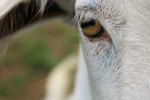
When you properly restrain your cattle to administer vaccines, you ensure your cattle get the proper vaccine dose for optimum protection against serious and fatal diseases. You also reduce the chances of injury to you and other handlers, as well as your cattle. Fortunately, you don’t need much equipment for proper vaccination.
Halter
Taking the time to acquaint your cattle with a halter will make the vaccination process easier. If your animals are exceptionally tame, a halter may be all you need, but it's highly unusual for any animal to stand still after feeling the prick of a needle. Still, it's easier to catch and lead cattle into the vaccinating area if they are halter broken.
Head Gate
A head gate is, as its name implies, a gate with an opening for a cow’s head. Once the cow is in place, you close panels or doors around the cow’s head and neck so she is secure. Many head gates are sold as part of a chute; you lead or herd cattle one at a time into the chute toward the head gate, then close the tail gate at the back. The chute is narrow so they can’t turn around, restricting their movements to make vaccinating easier.
Syringes and Needles
Use disposable syringes for each individual vaccine for better hygiene. You attach a needle to each syringe and then draw the proper vaccine dose into the syringe. Once you administer the vaccine, dispose of both needle and syringe properly. Some cattle owners use a metal syringe or injection gun. The downside of this reusable syringe is that it has to be sterilized with boiling water between uses -- never with a chemical disinfectant or you compromise the vaccine.
Injection Types
Vaccines are administered in three ways: intramuscular, subcutaneous or intradermal. Most cattle owners can easily give subcutaneous injections, as the needle is positioned just under the skin. You need to insert the needle into the muscle for an intramuscular injection, which isn’t difficult but may take some practice so you don’t hit a blood vessel or cause an abscess. Call your vet to administer intradermal vaccinations.
References
- Oklahoma Cooperative Extension Service, Division of Agricultural Sciences and Natural Resources: How to Vaccinate
- Cattle Today: Blackleg
- New York State Department of Health: Brucellosis
- University of Wisconsin-Madison, Animal Sciences: Infectious Bovine Rhinotracheitis
- Novartis Animal Health: Bovine Viral Diarrhea
- American Cattleman: Cattle Chutes Product Review
Resources
Photo Credits
-
Jupiterimages/Photos.com/Getty Images
Writer Bio
Based in Central Texas, Karen S. Johnson is a marketing professional with more than 30 years' experience and specializes in business and equestrian topics. Her articles have appeared in several trade and business publications such as the Houston Chronicle. Johnson also co-authored a series of communications publications for the U.S. Agency for International Development. She holds a Bachelor of Science in speech from UT-Austin.



